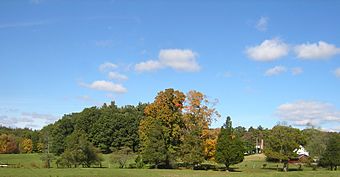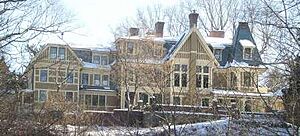Hunnewell Estates Historic District facts for kids
Quick facts for kids |
|
|
Hunnewell Estates Historic District
|
|

View of fields and pastures at Hunnewell Farm, Pond Road and Washington Street.
|
|
| Location | Wellesley, Massachusetts |
|---|---|
| Built | 1770 to 1891 |
| Architect | Arthur Gilman, John Sturgis, Gridley J.F. Bryant, Ware & Van Brunt, Stanford White, and Shaw & Hunnewell. |
| Architectural style | Colonial, Italianate, Colonial Revival, Late Victorian, 19th & 20th Century Revivals. |
| NRHP reference No. | 88000438 |
| Added to NRHP | April 14, 1988 |
The Hunnewell Estates Historic District is a special area with old buildings and land. It's located between the Charles River and Lake Waban in Wellesley and Natick, Massachusetts. This district is about 17 miles west of Boston. It includes many farms, gardens, homes, and landscapes. These properties belonged to the Hunnewell and Welles families. They date from the 1700s to the 2000s. Most of the properties are still owned by the Hunnewell family today. This historic district was added to the National Register of Historic Places in 1988.
All the places within this district are private homes. This means they are not open for the public to visit.
Contents
History of the Hunnewell Estates

The Hunnewell estates began in 1763. That's when Samuel Welles (1725-1799) bought land in Natick and West Needham. West Needham later became Wellesley. Samuel Welles was a descendant of Thomas Welles (1594-1660). Thomas Welles was the first Treasurer and later Governor of the Connecticut Colony.
The properties were passed down to Samuel's granddaughter, Isabella Pratt Welles. She married Horatio Hollis Hunnewell (1810-1902). He was a successful businessman and helped build railroads. He was also a landscape designer and loved plants. The properties continued to be owned by their children and later generations.
Hunnewell Family's Contributions
Mr. Hunnewell and his family gave a lot to the town of Wellesley. The town was even named after his wife's family, the Welles. They also helped Boston through philanthropy. This means they gave money and time to help many different causes.
They were also very generous to the plant-growing community in New England. For over 75 years, they brought in new plants. They tested them and shared them with others. They also showed great examples of garden design. They were leaders in the Massachusetts Horticultural Society. Horatio Hollis Hunnewell was especially interested in evergreen trees and Asian rhododendrons.
At their busiest time, in the early 1900s, there were twenty Hunnewell estates. They were all connected along Washington Street and Pond Road in Wellesley. These estates have been in the Welles-Hunnewell family for eight generations.
Protecting the Hunnewell Lands
The Hunnewell family has protected hundreds of acres in the district. They did this by placing them under "conservation restrictions." This means the land cannot be developed. Most of these protections are with The Trustees of Reservations. This helps protect Lake Waban and the Charles River. It also saves the farmland, gardens, and natural landscapes from being built on. These protections started in 1974. They were some of the first of their kind with the Trustees of Reservations.
Public Access to the Estates
None of the properties are open to the public. However, the family has traditionally allowed students and staff from nearby Wellesley College to walk a private path. This path goes around Lake Waban. But, when Wellesley College closed its campus in March 2020 due to the Covid-19 pandemic, the lakeside path was also closed. It will remain closed until further notice.
Buildings in the Historic District
The district includes the original Welles family home. It also has the Hunnewell Farm. Plus, there are eight country houses and other buildings. H. H. Hunnewell built these for himself and seven of his nine children.
- "Welles House" (1770) - This is the original country home of the Welles family. It is built in the Colonial style.
- "H. H. Hunnewell estate" (1851) - This was the home of H. H. Hunnewell and his wife. It's in the Italianate style. Arthur Gilman designed it. It includes the famous lakeside Italian Garden (1854). This was the first topiary garden in the United States. It also has an Pinetum (a collection of pine trees) from 1867. In 1865-1866, two gate lodges were built. A large conservatory (a glass building for plants) was added to the house. All these were designed by Gridley J.F. Bryant. The estate also has a 1755 house. This house belonged to Captain Aaron Smith. He led 70 Minutemen to the Battles of Lexington and Concord. Mr. Hunnewell designed his own landscapes. His original design is still almost completely the same today.
- "The Cottage" (1870) - This was a guest cottage in the Queen Anne style. John Sturgis designed it. Its landscape was designed in 1923 by the Olmsted Brothers.
- "The Oaks" (1871) - This was the home of Arthur Hunnewell (1845-1904). John Sturgis designed it. It burned down in 1891. A new home was built in its place, designed by Shaw & Hunnewell. This property also had the first private golf course in New England (1892). It was used until World War II.
- "Walter Hunnewell House" (1875) - This was the home of Walter Hunnewell (1844-1921). It's in the Stick style. Ware & Van Brunt designed it. It has many features similar to their design for Memorial Hall at Harvard. That building was designed around the same time. In 1881, Stanford White redesigned the front entrance and one room inside.
- "Hill Hurst" (1883) - This is a brick home in the Château style. It belonged to Hollis Hunnewell (1836-1884). Shaw & Hunnewell designed it. It included squash courts built in 1892. These were the first of their kind in the United States.
- "Hunnewell Farm" (1887) - This is a 30-acre working farm. It's located on the border of Natick and Wellesley. John Welles bought it in 1814. But farming had been done there since colonial times. The large barn there today was built in 1887. It measures 90 feet by 40 feet. Its haylofts can hold 10,000 bales of hay.
- "The Cedars" (1891) - This was the home of Henry Sargent Hunnewell (1854-1931). Shaw & Hunnewell designed it. It had a large landscape designed by Charles Eliot. This design featured long "view avenues" pointing towards Morse's Pond and other sights. The original house was taken down in 1953. A smaller brick house was built in its place in 1954.
- "The Morrill House" (1775) - This was the home of Dr. Isaac Morrill. John Welles bought it in 1836. It then went to his daughter, Isabella Pratt Welles, who was H. H. Hunnewell's wife. The house was made much larger in 1891. These plans were by Shaw & Hunnewell. It became the home of Jane Welles Hunnewell (1851-1936) and her husband. Jane Hunnewell Sargent was the grandmother of Francis W. Sargent. He was the Governor of Massachusetts from 1969-1975.
- "The Pines" (1891) - This was the home of Isabella Pratt Hunnewell (1849-1934) and her husband Robert Gould Shaw. Shaw & Hunnewell designed it. This Robert Gould Shaw is not the same as his cousin. His cousin commanded the African-American 54th Regiment Massachusetts Volunteer Infantry during the US Civil War. This property is no longer owned by the family. It was sold to Wellesley College in the 1970s.




